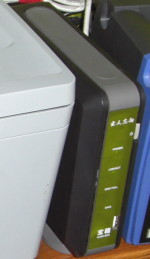Kurbox Upgrade; or: Musings on Network Appliances and Embedded Operating Systems
 I spent most of Saturday trying to put a new hard drive in my Kurobox. The Kuro, named Lulu, has really become quite central to our life here at home since I got it, which is coming up on two years now (I think). It acts as a print server, a scanner server, a file server, and a TiVo media server (via Galleon), all on a minuscule 266MHz PPC processor and a paltry 128MB of memory. It has a very small profile, is super-quiet, and uses a tiny amount of power. Basically, it just sort of sits there doing its thing. (Before yesterday, I had over 400 days of uptime! It doesn’t hurt being on the same power grid as the White House…)
I spent most of Saturday trying to put a new hard drive in my Kurobox. The Kuro, named Lulu, has really become quite central to our life here at home since I got it, which is coming up on two years now (I think). It acts as a print server, a scanner server, a file server, and a TiVo media server (via Galleon), all on a minuscule 266MHz PPC processor and a paltry 128MB of memory. It has a very small profile, is super-quiet, and uses a tiny amount of power. Basically, it just sort of sits there doing its thing. (Before yesterday, I had over 400 days of uptime! It doesn’t hurt being on the same power grid as the White House…)
But when I bought it, I wasn’t sure it would actually do what I wanted it to do, so rather than drop another couple hundred bucks for a hard drive that might prove useless in the event I bricked the Kuro, I conned a good friend of mine into letting me borrow an old 40GB drive to just throw in it.
Well, after complaining about the lack of space for some time now, yesterday Lulu got an upgrade from 40GB to 500GB. While I had her on the floor in pieces, I realized with some delight that the Chumby has significantly more CPU power and twice as much RAM as the Kuro. Crazy!
The era of the general-purpose personal computer really is over, isn’t it? Not because we’re going to stop using them, but because specialized appliance-like devices are taking over. There are six devices listed in the device table of my router right now, and only two of them are computers. The rest are: the TiVo, the Wii, the Chumby, and the Kurobox. There’d be seven, but the DS isn’t on right now. Each of them is quite specialized to its task, and each has its own purpose for being on the network. In some cases, like the Kuro and the TiVo, they interact in powerful ways. In others, like the Wii and the DS, they are quite seperate.
Also interesting is the selection of operating systems. None of the appliances in our home runs anything from Microsoft. Rather, they are either custom firmware, or Linux. If specialized appliances really are taking over the home, it seems clear to me that Microsoft has already been shown the door in the arena of embedded operating systems. I don’t even think the XBox or XBox 360 counts as a win for them; my understanding is that it runs custom code, and shares very little with Microsoft’s other operating systems.
